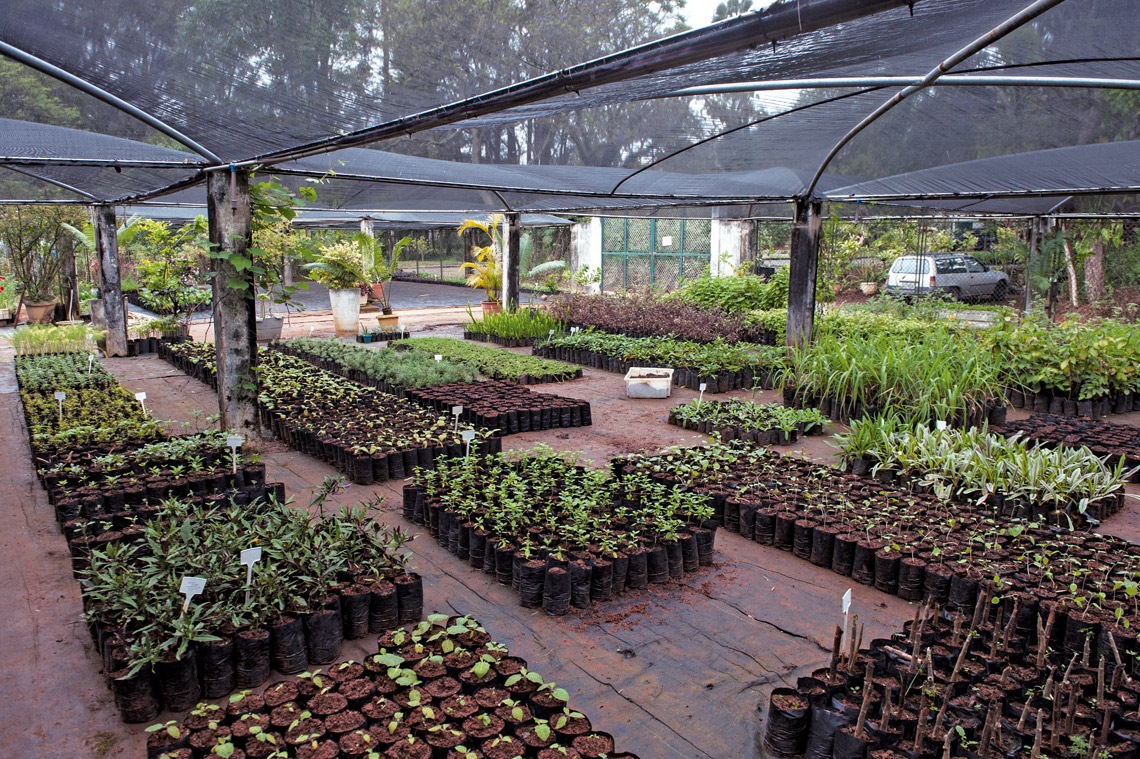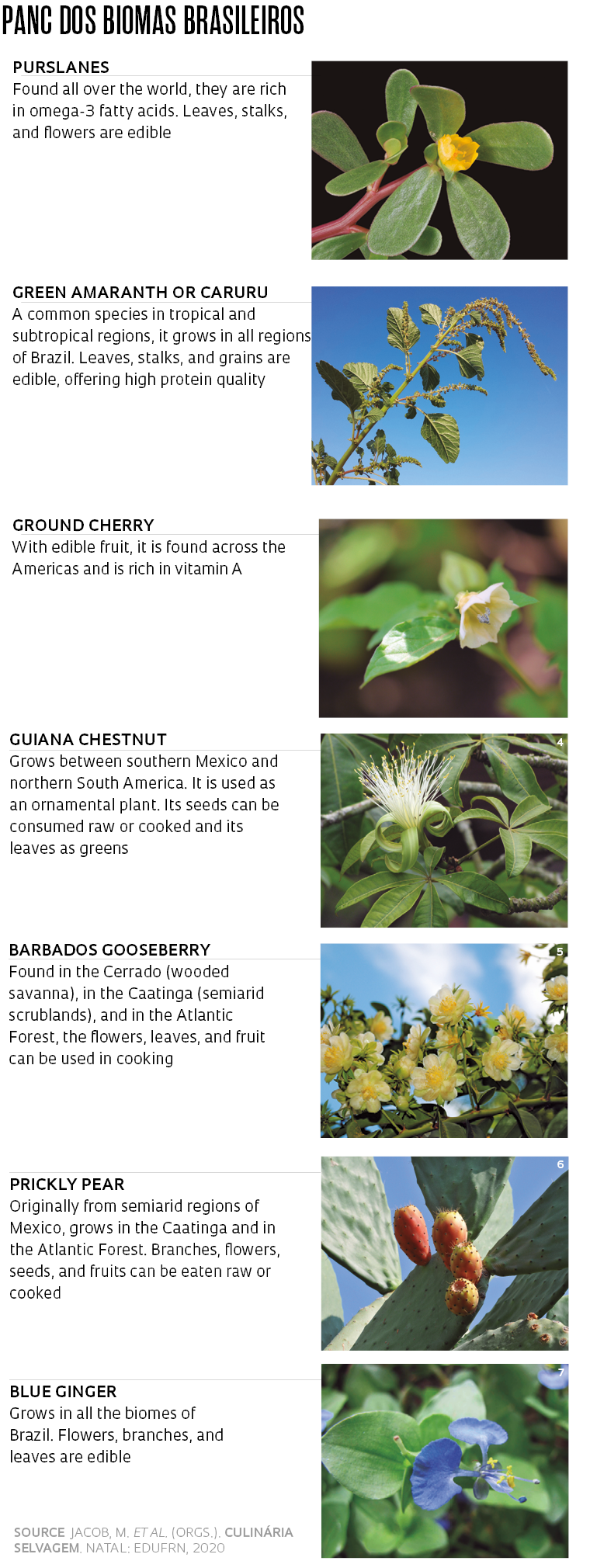In a scenario in which half of global food consumption of vegetable origin is derived from wheat, corn, and rice, according to data from the Food and Agriculture Organization (FAO), the inclusion on the menu of Non-Conventional Food Plants, known as PANC, emerges as a possibility for diversifying people’s diets. Committed to finding strategies capable of spreading their use, ethnobotanists, nutritionists, biologists, and agronomists have developed studies with the aim of identifying obstacles in the production chain and defining actions to win over the consumer’s taste buds.
PANC are plants, or parts of plants, that can be used as food, but are little known or underused by the majority of the population, especially in urban centers. From the finding that the diet of Brazilian society includes little variety of foods, ethnobotanist Patrícia Muniz de Medeiros, of the Federal University of Alagoas (UFAL), affirms that it is possible to increase the range of products consumed (see Pesquisa FAPESP issue nº 295), considering that at least 10% of the country’s vegetable biodiversity has food potential. “The more varied the diet, the more nutrients are ingested. Besides that, climatic changes will likely affect the cultivation of the most consumed species. PANC could work as an alternative in a scenario of uncertainties in the food system,” argues Medeiros.
Coordinator of a research group since 2017 that seeks to identify bottlenecks in the popularization of PANC consumption, which includes analyses of extractive activities and consumer habits, the ethnobotanist discovered that people over 60 years of age are the portion of the Brazilian population that most consume this type of product. It is also in this age group where there is most resistance to their consumption. “Many of these people associate their use with situations of hunger, which is why it is necessary to redefine these negative experiences,” she proposes.

Léo Ramos Chaves / Pesquisa FAPESP MagazineSpecies of PANC cultivated at Manequinho Lopes Nursery, in Ibirapuera Park, in São PauloLéo Ramos Chaves / Pesquisa FAPESP Magazine
Coined around 15 years ago by biologist Valdely Kinupp, of the Federal Institute of Amazonas (IFAM), the acronym PANC has helped popularize the consumption of these plants, in Medeiros’ opinion, to the extent that it attracts attention from the haute cuisine market and urban public. “However, some plants, such as genipap and cambui, are considered PANC, but in parts of Brazil their consumption is already widespread,” she says. With studies about the history of food in Brazil, journalist Phellipe Marcel da Silva Esteves, of Fluminense Federal University (UFF), agrees that the term PANC is effective for spreading their consumption, but says that it is inaccurate terminology. “There is not just one food custom in Brazil. In Rio de Janeiro and in São Paulo, for example, we don’t use cassava leaves in cooking, while it is common in Pará,” he states. For this reason, some researchers prefer using terms such as wild food plants, instead of the acronym.
A specialist in food biodiversity, with a project developed over the last four years to investigate consumption of PANC, mushrooms, and game meat in Brazil, Michelle Cristine Medeiros Jacob, professor of the nutrition course at the Federal University of Rio Grande do Norte (UFRN), is carrying out a study to analyze data from the latest Family Budget Surveys from the Brazilian Institute of Geography and Statistics (IBGE), in partnership with other researchers. In the survey, data related to the consumption of these three ingredients by around 39,000 people was extracted. “Considering the partial results, we can state that the greatest consumers of PANC in the country are women with an average income of R$1,400,” she says. She points out that, when comparing the three groups of products, PANC consumers have the profile closest to the average of the general population of Brazil, suggesting that these plants have a huge potential for inclusion in the diet. “Looking specifically at the PANC group in rural settings, its main consumers are people with lower incomes, that depend on natural resources to feed themselves. Whereas in urban areas, these consumers have higher incomes and are associated with a movement that has grown over the past 10 years, of valuing organic and traditional products from the country’s biodiversity,” she explains. Based on the collection of data, the proposal of the project coordinated by Jacob is to develop actions to popularize PANC consumption. The first step is teaching potential users to identify them. “The majority of people are botanically blind with regards to PANC, because they are not able to see them as food,” adds the nutritionist.
With the aim of collaborating to reduce this “botanical blindness,” Jacob has developed, in partnership with other researchers and students, a community PANC garden in UFRN. Created in 2017, it works as a laboratory and is used in different subjects of the nutrition and agronomy courses. Four PANC are studied each semester, including collecting data on their medicinal and cultural uses, and their biochemical compositions. The book Culinária selvagem (Wild cuisine; EDUFRN, 2020), finalist of the Jubuti award in 2021, compiles partial results of the project, as well as offering recipes. Last year, Jacob also published the work Local Food Plants of Brazil (Springer), in which researchers from different biomes of Brazil present data about the nutritional composition of edible plants from different regions of the country. “We do not have systematic knowledge about the nutritional composition of PANC and, by filling this gap, the book seeks to promote their consumption,” he says. Taking the UFRN laboratory-vegetable garden as a reference, the research group coordinated by the nutritionist has also supported the creation of another eight vegetable gardens in schools from the Metropolitan Region of Natal.

Léo Ramos Chaves / Pesquisa FAPESP MagazineManequinho Lopes Nursery in Sao PauloLéo Ramos Chaves / Pesquisa FAPESP Magazine
For Jacob, PANC show significant potential in the challenge of promoting food security. They enable the list of available foods to be expanded, they have the capacity to adapt to different temperatures, and they require little fertilization and water to develop. He evaluates that the low consumption of PANC, which usually grow without cultivation in the wild, in backyards, and even in town squares, is associated with the production chain of these foods. Transport to the end consumer often requires specific care to avoid them spoiling. Jacob mentions uvaia (Eugenia pyriformis), which grows in the Atlantic Forest, or umbu (Spondias tuberosa), native of Caatinga, as examples. “These fruits don’t last long after collection, they go bad quickly. To encourage their consumption, it is necessary to invest in processing, such as jam or frozen pulp,” he explains. Countries such as Madagascar, explains Kinupp, from IFAM, which already have PANC processing plants, are able to sell products in supermarkets made from jambu, black-jack and moringa, in the form of preserves. “Of around 400,000 plant species in the world, around 75,000 have food potential. However, because of the difficulties of identification and in the production chain, we only ingest around 200 of them,” Kinupp observes, an expert on the topic since his PhD, defended in 2007 at the Federal University of Rio Grande do Sul (UFRGS). His involvement with PANC has a family origin. His mother used to make recipes with ingredients such as banana flower, bull’s tongue [Elephantopus scaber], mustard, sow thistle, and tannia, available where they lived as a landless family.
The book Cozinheiro nacional (National chef), published between 1860 and 1880 and considered the first book published in Brazil with autochthonous menus, uses ingredients such as the Barbados gooseberry, sow thistle, purslane and tannia, all considered PANC, observes Esteves, from UFF. According to him, prior to this work, Cozinheiro Imperial (Imperial chef) presented translated recipes from classic European manuals. Around a century later, in the 1960s, the Enciclopédia da arte culinária da tia Thereza (Encyclopedia of the culinary art of aunt Thereza), a work in three volumes considered as a reference, included Malabar spinach among its recipes, but no other PANC.
Agronomist Nuno Rodrigo Madeira, from the Brazilian Agricultural Research Corporation (EMBRAPA), recalls that in the 1900s families in Rio de Janeiro ate plants that grew in backyards, including those today classified as PANC, but the practice was substituted by the ingestion of products cultivated in mass, especially in large cities. Curator of EMBRAPA’s non-conventional vegetable collection, Madeira has been working since 2006 on recovering ingredients that were once part of the Brazilian diet, including purslane and tannia, among others. “Besides the collection, we also do field work with farmers, showing them that these plants can reproduce quickly in small spaces,” he highlights, emphasizing that the focus of the initiative is teaching how to structure production systems with agroecological management. “In the case of Barbados gooseberry, for example, also used as a living fence, we suggest successive and staged pruning to encourage the production of a less prickly plant. This way, it remains small and with few thorns. This can aid its handling,” he advises. According to him, another challenge involves increasing knowledge about the nutritional scale of these plants which is very variable. There are four species of Barbados gooseberry alone, and 60 varieties, with a protein level that ranges between 17% and 32%.


